Ruger Gp100 357 8 Shot 3 Inch Barrel Review Videos
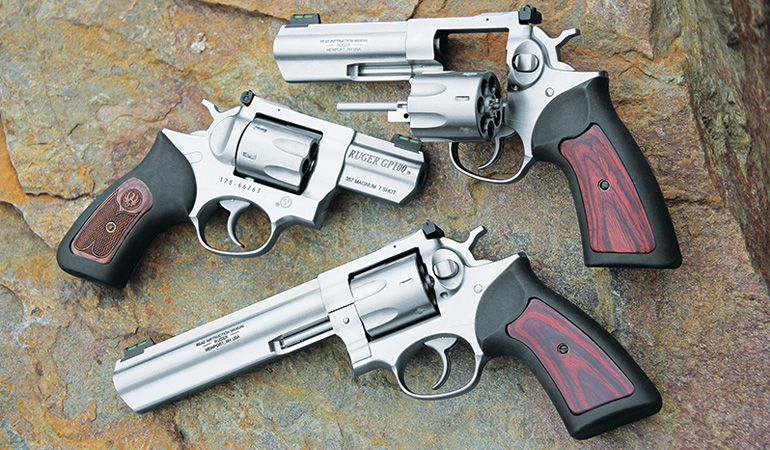
January 15, 2019
Any list of the top American gun designers really must include Neb Ruger. Some of Ruger's designs—similar the Blackhawk, 10/22 and Marking I—set new standards for accuracy, safe and reliability in their corresponding classes. Ruger knew how to dress up a firearm to brand it both centre-catching and functional—guns similar the M77 Mark 2 Safari rifle that combined the look and feel of London's Bond Street big bores with the functionality of a controlled round feed action at a fraction of the price of Rigbys, Purdeys and the like. The No. ane falling block, which some called outdated at the time of its release, has developed something of a cult post-obit.
But perhaps the most overlooked of all Ruger'southward contributions to the earth of modern firearms are his developments to improve the blueprint of the double-action revolver. In the early on 1970s Ruger developed his Half dozen series wheelguns, a family that included the Security-Six, Speed-6 and Service-Six. All these guns featured investment-bandage frames, transfer bar system and a coil bound design.
The Half-dozen firearms were standouts in the pop double-action marketplace in the 1970s and '80s, but by the mid-'80s Neb Ruger was looking to amend those designs. Specifically, he wanted a slightly larger medium-frame revolver that was robust plenty to handle round after round of the hottest .357 Magnum ammo available.
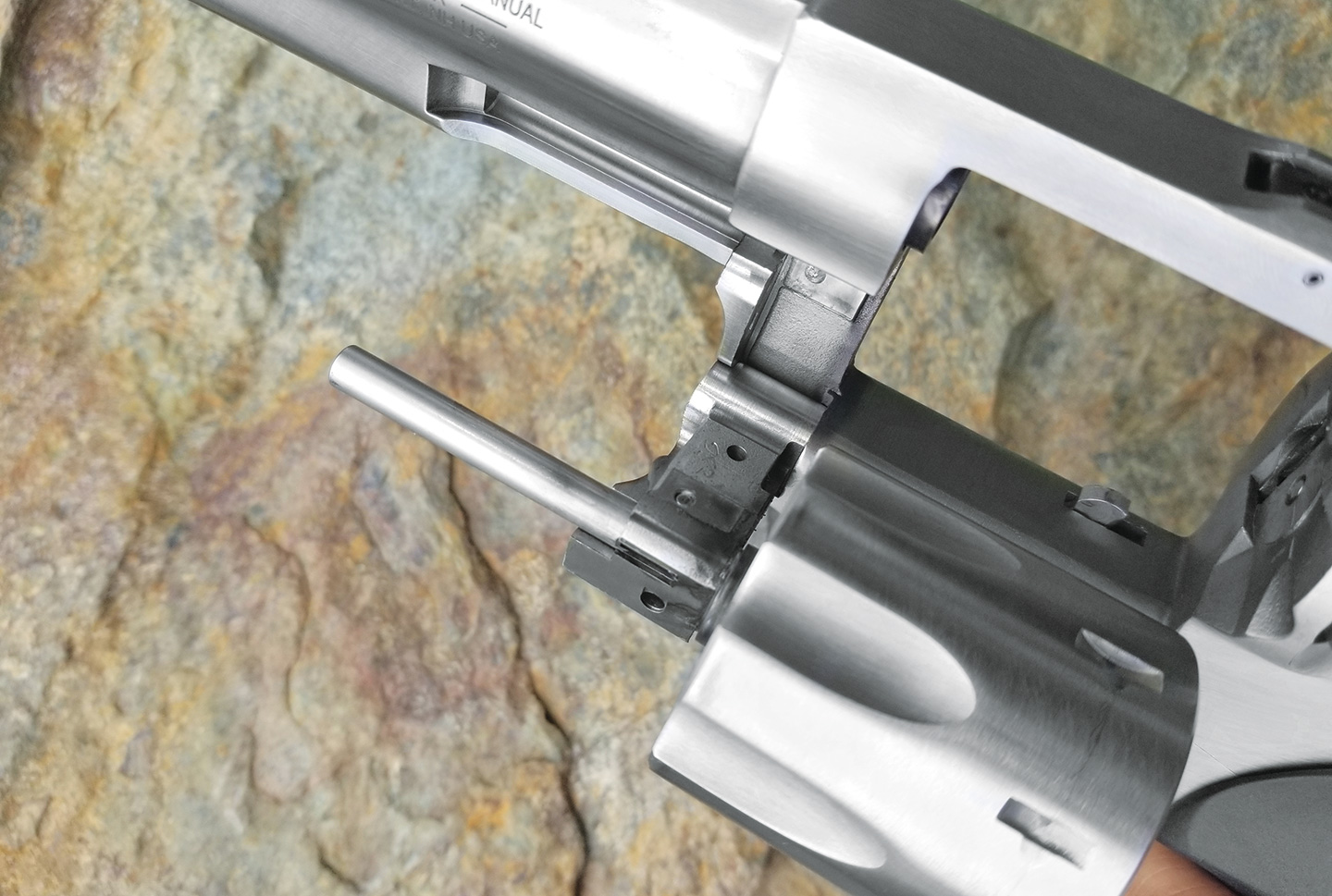
Enter the GP100. But the GP100 was more than than a beefed-upward version of the Six revolvers. For starters, these guns offered a new Triple Locking design that held the cylinder in identify. There's a lock in the frame at the crane too equally a lock at the ejector rod and a bolt at the bottom portion of the cylinder that prevents cylinder rotation when it is engaged.
Additionally, the GP100's shorter, stubbier grip post allowed for a wide variety of unlike grips to exist installed, a difference from the traditional full-frame pattern found on many double-activity revolvers at the time. The GP100 was, and is, bachelor with fixed or adaptable sights and in either a blued or satin stainless finish. Additionally, these guns were, and are, affordable.
I've got a soft spot for the GP100. My male parent has a six-inch stainless model that a gunsmith tuned to virtually-perfection, and it was the first centerfire revolver I ever fired. Information technology's notwithstanding one of his favorite guns, and it nevertheless appears to be a fresh-from-the-box gun despite years of difficult shooting. And my dad isn't alone in his appreciation for the GP100's many attributes. There are a number of shooter who however consider these guns to be among the finest medium-frame .357 Magnum wheelguns always offered at any price signal.

Ruger has made minor changes to the GP100 over the years, offering it in various calibers and designs, including the Match Champion version that debuted a few years dorsum. About recently, Ruger upped the ante by adding an extra round to the GP100's beefy cylinder. There are three barrel lengths available with vii-shot cylinders—2.v, 4.2 and six inches—all in satin stainless with Ruger'south trademark elastomer rubber grips with hardwood inserts.
I had a hazard to test all three versions with various loads ranging from balmy-mannered .38 wadcutters all the way up to hot .357 Magnum loads for defense and hunting applications. Each gun was subjected to the standard exam protocol of five 5-shot groups with five separate loads, and each of these guns has its own personality and main purpose.
The Fill-in: two.five Inch
The shooting world is flush with ultra-lite, ultra-compact .357/.38 revolvers for personal defence force. In this smaller-is-better universe the GP100 2.five-inch seven-shot is a behemoth, weighing in at a stout 33.7 ounces on my digital scale and measuring roughly 5.5 inches alpine with an overall length of eight inches. The cylinder measures merely under ane.4 inches wide, so this wheelgun has specs more closely resembling those of a full-size 1911 than a tuckable behave revolver like Ruger'south LCR.
Just if you're into conveying a revolver for defense force against two- or four-legged predators, the GP100 7-shot 2.5-inch has some real advantages over smaller .357 revolvers. The Triple Locking cylinder is i of those.
I owned a compact .357 revolver for backup that gave up the ghost and allowed the cylinder to spin freely subsequently a few hundred rounds of .357 ammo, which is a pretty terrible feeling when information technology'due south the gun yous're counting on to save your life. The Ruger'due south time-tested system is durable and solid, so there's less chance that you'll have to deal with such shenanigans.
Medium-frame guns are harder to conceal than ultralight revolvers simply are much more pleasant to shoot since the grip is larger and at that place's more than bulk to assist mitigate the muzzle rising from hot .357 defensive loads. Sure, muzzle blast is more pronounced with this shortest of all GP100s, just it isn't an unpleasant gun to shoot, and for a compact revolver, information technology's relatively accurate.
The accuracy is due in large part to the fact that this revolver comes equipped with real, functional, adjustable iron sights. Instead of the ascetic channel-and-post sights found on most pocket revolvers, the GP100 2.5-inch vii shot has a windage- and elevation-adaptable white-outline rear sight and a forepart sight with a green fiber-optic insert that is dovetailed into the solid top rib. Final, the Ruger offers at least ane and perchance two more rounds than yous'll get from the smallest defensive wheelguns.
In single-action manner the trigger on the test revolver broke at 4.2 pounds on my RCBS calibration, and in double-action way it broke at 10.4 pounds. There's minimal stacking in DA mode, and the trigger guard is large plenty to be accessible even with gloved fingers.
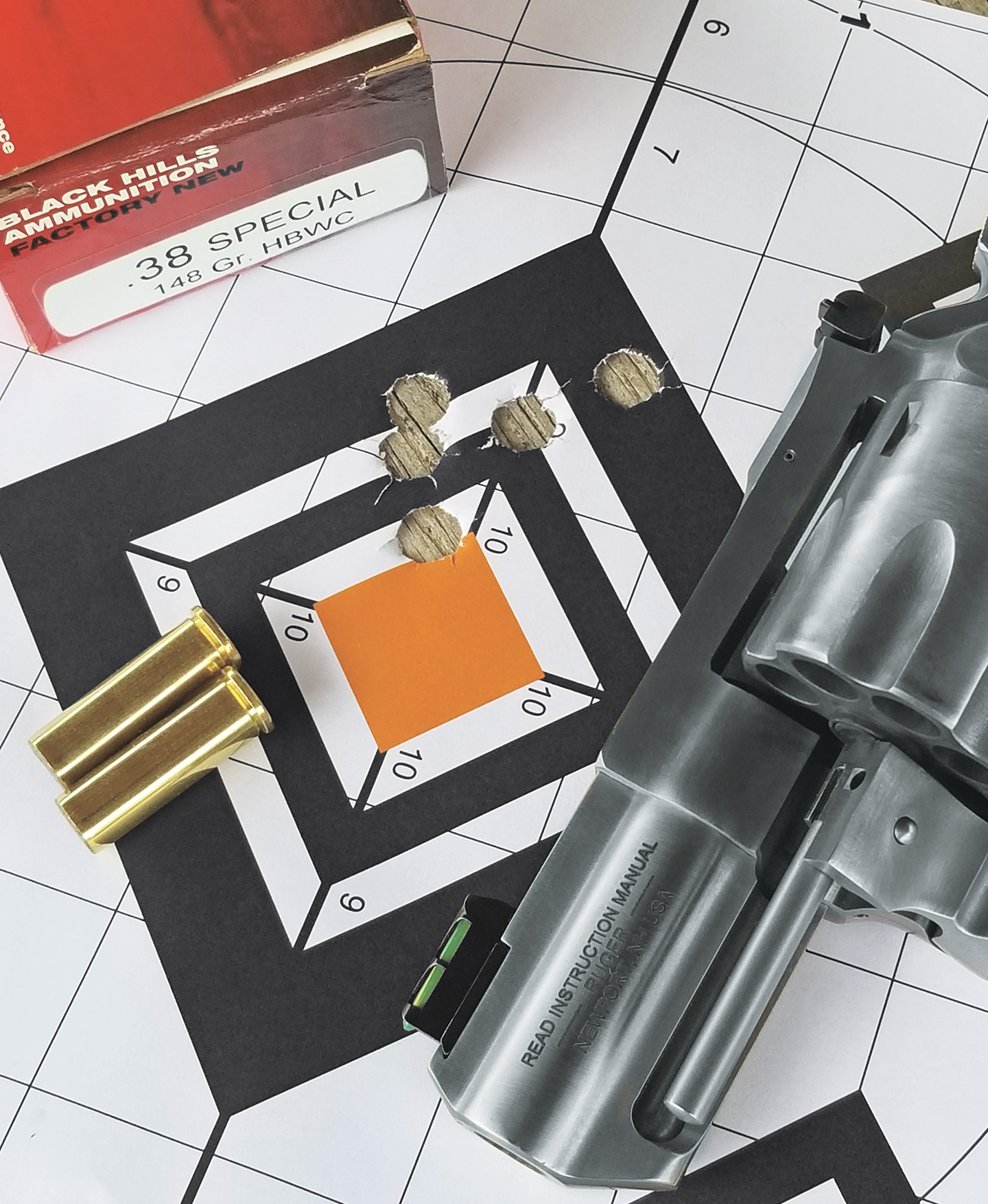
At xv yards the average groups were respectable for a revolver with such a chubby butt, ranging, on average, from 1.eight to two.5 inches. At roughly 45 anxiety those are pretty good numbers for this class or revolver, and the 2.5-inch GP100 really shines when shooting offhand at defensive distances. The double-activity trigger pull is rather long, but in single activity it'due south crisp and smooth.
The gun's weight and large grip go far easier to deliver fast follow-ups than with other, smaller defensive handguns, and although this gun will be noticeably more difficult to conceal than more compact revolvers I can clinch you that anyone—new shooters in item—will appreciate this wheelgun's manageable demeanor.
If you're looking for an open comport defensive revolver and don't desire to step up to a larger four-inch gun, this model is a sensible option. It should besides exist noted the 2.5-inch version comes with smaller grips and panels than the 4.2- and vi-inch versions. Information technology may help in darkening and makes the gun look more proportionally correct, but there'south notwithstanding enough of grip on this smallest GP100. Suggested retail on this and the other new 7-shot GP100s is $899.
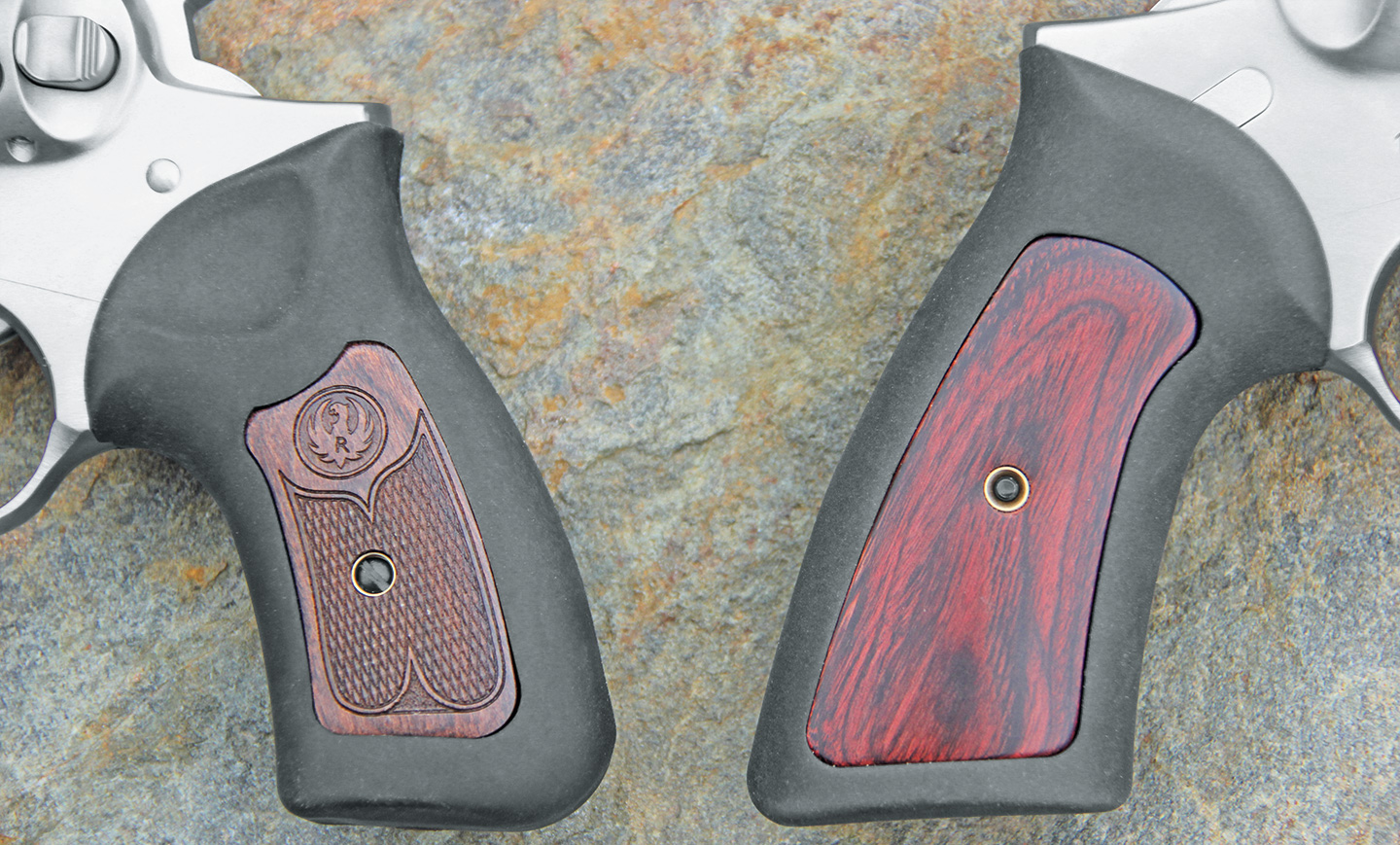
Riding the Fence: four.2 Inch
There was a time not so long ago when four-inch .357 revolvers were the gun of choice for law enforcement agencies, and the Ruger shows that the midsize, medium-frame revolver is still a solid choice for personal defense. I think it'due south safe to say it's oversized for daily curtained carry, but at 40 ounces this gun isn't so large it'south cumbersome to carry on the hip.
The iv.2-inch butt gives the gun an overall length of roughly x inches, and the extra length stretches the sight radius for improved accuracy. Like the other GP100s in the test, the iv.2-inch comes with a full-length underlug that'south machined to the barrel. All these guns characteristic the same sight setup with screw adjustments on the rear sight.
The 4.2-inch comes with the same full-size grip you'll detect on the six-inch model. This adds about a half-inch to the overall summit of the two.5-inch model, and the extra meridian offers additional space on the elastomer grip for very large hands. And just similar the other guns in the test, the medium-sized frame offers plenty of space to keep your thumbs well away from the cylinder gap when firing.
The iv.ii-inch revolver rides the fence betwixt the stubby 2.v-inch and the hefty six-inch version, and it might well be the most versatile revolver of the bunch. Weight is withal manageable for all-day conduct, and the barrel clears the holster noticeably sooner than the larger six-inch model. But the four.two-inch model offers better accuracy at extended ranges and higher velocities than yous get from the brusque 2.5-inch gun while retaining some level of portability.
The all-time group boilerplate at 25 yards measured just ane.8 inches, the aforementioned as the two.5-inch model at 15 yards. Velocities were higher, and muzzle rise and blast were less thanks to the longer butt. The 4.2-inch model also offered the best single-activity trigger pull at 3.8 pounds, and double-activeness trigger weight was x.6 pounds.
Go Large: Six Inch
With its long pipage, the half-dozen-inch GP100 offers the best velocities and produced the smallest boilerplate groups, and recoil even with the hot .357 Magnum loads was then manageable even new shooters could handle it. Forget carrying this pistol concealed, though. It weighs 45 ounces and measures 12.five inches long, so this revolver is best suited for target practice and field carry or hunting, and it excels in those roles.
The .357 Magnum's effectiveness on deer is a matter of opinion, only many pig hunters like the circular (and they'll really like having one more shot bachelor). Hound hunters who pursue cougars will detect that the six-inch Ruger's added sight radius and increased power thanks to an uptick in velocity serve well.
But fifty-fifty if your ambition isn't to follow a pack of lion hounds through steep canyon country, you lot'll notwithstanding appreciate all this gun has to offering. It makes an excellent trail gun, with .357 Magnum ability to take on near any threat you lot're likely to encounter when hiking or camping. It's a pussycat with .38 Special loads, and it'due south accurate plenty to punch paper targets, pop cans and metal plates all day long.
Like its brethren, the six-inch gun comes in stainless with a satin cease, and that's a good thing considering while testing this gun the skies opened and gun and shooter were defenseless in a torrential downpour. A wipe down was all that was needed to bring the Ruger back to its previous state. Also, the Ruger grips, which some shooters dearest and some don't, piece of work very well in wet weather.
This model favored Federal'southward 180-grain hunting load, averaging just over ane.5 inches at 25 yards in terrible conditions. But the six-inch shot every load relatively well, with two of the five loads averaging under two inches and the other iii striking shut to that figure. The six-inch Ruger, like the two guns listed before, showed no signs of habiliment, and there were no issues with operation. These guns are, pardon the pun, bulletproof.
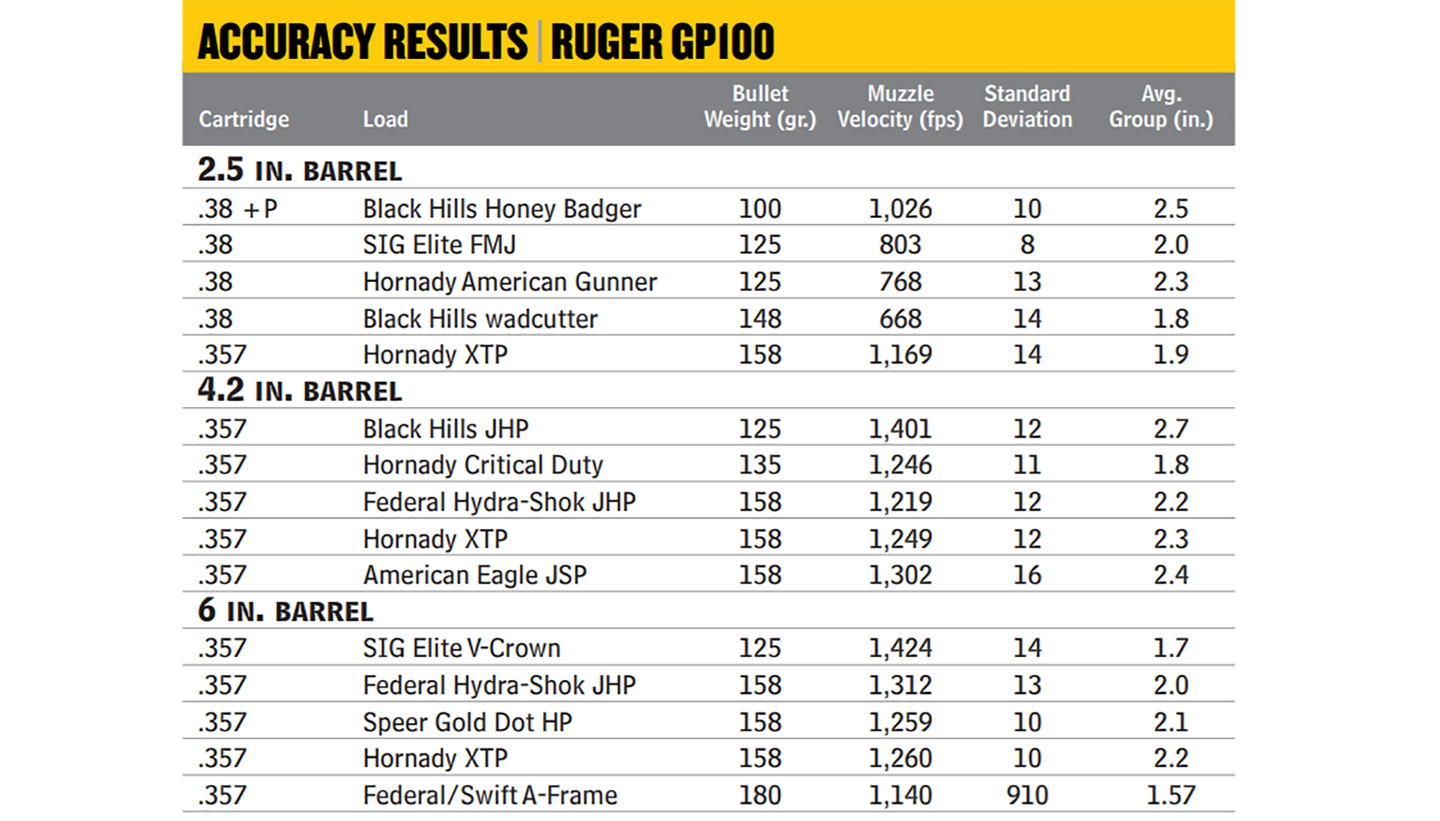
If you're a revolver fan, y'all won't be disappointed when adding 1, two or all 3 of these guns to your collection. If you've grown tired of polymer guns and you're in the mood for something congenital from solid steel, you lot'll dear these revolvers. And Ruger has managed to upwards the ante on an otherwise great gun by making room in the cylinder for one additional round.
Ruger GP100 7-Shot
Action: double-action revolver
Caliber: .357 Magnum
Chapters: 7
Barrel: 2.5, 4.2, vi in.
Overall Length: 8–12.5 in.
Weight: 33.7–45 oz.
Peak: 5.5 in.
Grips: elastomer with wood panel inserts
End: satin stainless
Trigger: varies; see article
Sights: fiber-optic front sight, adaptable rear
Toll: $899
Manufacturer: Ruger, ruger.com
pattersonchen1991.blogspot.com
Source: https://www.handgunsmag.com/editorial/review-ruger-gp100-7-shot-357-magnum/330920
0 Response to "Ruger Gp100 357 8 Shot 3 Inch Barrel Review Videos"
Post a Comment